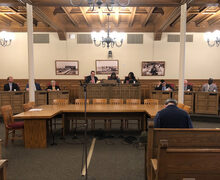Who’s laughing now: Laugh tracks could be the death of sitcoms
Courtesy of CBS
The popular sitcom "The Big Bang Theory" is a frequent culprit of overusing laugh tracks.
UPDATED: Sept. 27, 2017 at 11:48 p.m.
The first sitcom in the United States, “Mary Kay and Johnny,” emerged in 1947 as an outlet for post-World War II American families to redefine the idea of a nuclear family. Shows like “I Love Lucy,” “Frasier” and “The Golden Girls” are just a few examples of sitcoms that became extremely popular throughout the years.
While sitcoms like “One Day At A Time,” “Disjointed” and “Young & Hungry” have gained popularity, the concept of a sitcom is dying. Obsessive TV watchers, such as myself, are starting to see a trend in the kind of comedy shows that seem favorable. While sitcoms like “The Big Bang Theory” are still in demand, one of its most significant technical aspects is actually hurting the popularity of sitcoms in general.
I’m talking about the dreaded laugh track.
While this annoying feature has been a staple in the sitcom format, it isn’t a necessary one. It’s mostly a nuisance. Laugh tracks emerged as a method of indicating where the humor was applied, but now they’re used every time Sheldon Cooper opens his mouth on “The Big Bang Theory.”
I used to enjoy watching the show and, as an extension of it, numerous other sitcoms. But the monotonous laughter got so annoying that I began to hear laughs tracks in my sleep and wake up in a cold sweat the next morning. The absurdity of laugh tracks just adds to the unnecessary plot lines and dragged seasons.
Laugh tracks can be credited for a number of recent shows that haven’t been able to garner attention. Even having Kathy Bates in the lead couldn’t save “Disjointed,” a venture by Chuck Lorre of “The Big Bang Theory.”
“Disjointed” is about a group of dysfunctional people who run a pot dispensary. One would think this could’ve been a big hit considering the show is on Netflix, but alas, no.
Another sitcom to be cut before it could prove itself was Freeform’s “Young & Hungry.” With Hannah Montana’s BFF Emily Osment in the lead, we were getting a less funny, slightly whiny version of “Cory in the House.” Yet I refuse to believe it was anything but the overused laugh track that killed the show.
One of the only reasons “The Big Bang Theory” has survived so far is because it was introduced to the world during a dark time – the 2000s. This was a period in TV history when audiences had seen it all – shows set in offices, shows set in hospitals, shows set in Kim Kardashian’s house, etcetera.
The popularity of “The Big Bang Theory” stems from its strategic timing and the ability to make nerds cool, which helped it gather a large fan base.
But it’s a different era. TV is getting more innovative and competition is growing. To have a hit TV show, the concept has to be something no one has seen, thought or even dreamed of.
While sitcoms like “TBBT” are part of the lucky few oldies that are well above the water, I wouldn’t give it long before its audiences get tired of pretending that the jokes are funny because the laugh track says so.
Conclusion: Laugh tracks are the devil. Stay away.
TV columnist Malvika Randive enjoys funny shows. Just not as much when recorded laughter tells her when to laugh.
The story has been updated with appropriate style.
Published on September 27, 2017 at 11:37 pm





